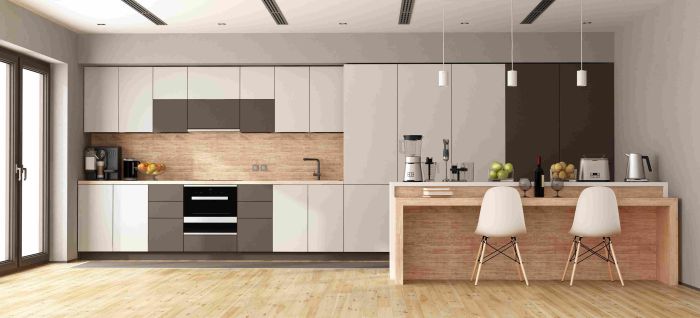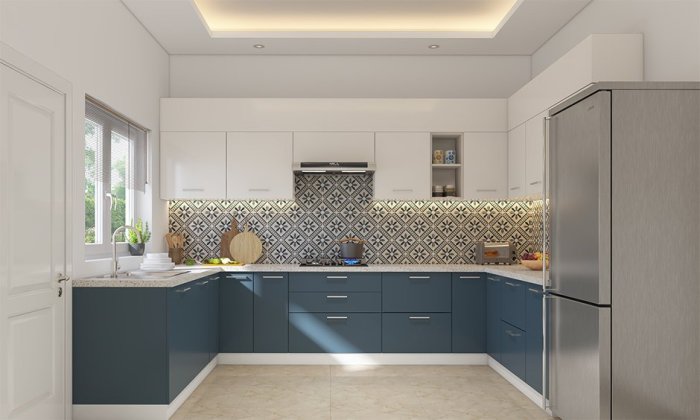Kitchen Flooring Trends: Kitchen And Floor Decor

Kitchen and floor decor – Kitchen flooring is a crucial design element, impacting both the aesthetic appeal and the functionality of this central hub of the home. Choosing the right flooring requires careful consideration of factors such as durability, style, maintenance, and budget. Current trends reflect a move towards versatile, durable materials that can withstand heavy foot traffic and spills, while also complementing a range of design aesthetics.
Kitchen Flooring Layouts and Material Comparison
Selecting a kitchen floor layout involves considering the kitchen’s shape, size, and traffic patterns. The choice of material significantly influences the overall look and feel, as well as the practicality of the space. Below are five different kitchen flooring layouts using various materials, along with an analysis of their advantages and disadvantages.
- Layout 1: Large-format Porcelain Tiles in a Chevron Pattern: This layout offers a sophisticated and timeless look. The large tiles minimize grout lines, creating a clean, modern aesthetic. The chevron pattern adds visual interest and can make the room appear larger. However, the installation can be complex and expensive, and large tiles may be more susceptible to cracking under stress.
- Layout 2: Wide Plank Engineered Hardwood in a Straight Lay: Engineered hardwood provides the warmth and beauty of natural wood with enhanced durability and stability. A straight lay pattern is classic and versatile. It is relatively easy to install and maintain, but it’s more susceptible to water damage than tile and can be more expensive than vinyl.
- Layout 3: Luxury Vinyl Plank (LVP) in a Herringbone Pattern: LVP offers a cost-effective and durable alternative to hardwood or tile. A herringbone pattern adds visual interest and sophistication. LVP is water-resistant and easy to clean, but it may not have the same longevity or luxurious feel as natural materials.
- Layout 4: Small Mosaic Tiles in a Random Pattern: Small mosaic tiles create a unique and textured surface. A random pattern adds a playful and artistic touch. While highly durable and easy to clean, the numerous grout lines require more maintenance and can be challenging to clean thoroughly.
- Layout 5: Combination of Materials: Tile in High-Traffic Areas, Wood in Dining Area: This approach combines the best of both worlds, using durable tile in areas prone to spills and moisture (like near the sink and stove) and warmer wood in the dining area. This approach is highly customizable and can create a visually interesting space, but it requires careful planning and coordination of materials.
| Material | Durability | Cost (Relative) | Maintenance |
|---|---|---|---|
| Porcelain Tile | High | High | Medium |
| Engineered Hardwood | Medium | High | Medium |
| Luxury Vinyl Plank (LVP) | Medium-High | Medium | Low |
| Mosaic Tile | High | Medium-High | High |
Kitchen Flooring Styles
The choice of flooring significantly contributes to the overall style of a kitchen.
- Modern Kitchen Flooring: Modern kitchens often feature sleek, minimalist flooring. Think large-format, polished concrete slabs in neutral tones like gray or off-white, or large rectangular porcelain tiles in cool, monochromatic shades. The textures are typically smooth and even, with a focus on clean lines and uncluttered surfaces. A subtle, almost imperceptible pattern might be incorporated, but the overall effect is one of simplicity and sophistication.
- Farmhouse Kitchen Flooring: Farmhouse kitchens embrace rustic charm and warmth. Wide-plank, reclaimed wood flooring in warm tones like honey or chestnut is a popular choice. The wood might have visible knots and imperfections, adding to its character. Alternatively, patterned ceramic tiles reminiscent of vintage floorcloths or encaustic tiles can create a charming, nostalgic atmosphere. The textures are generally textured and uneven, reflecting the rustic aesthetic.
- Minimalist Kitchen Flooring: Minimalist kitchens prioritize clean lines and functionality. The flooring often consists of simple, light-colored materials, such as light-grey or white large-format porcelain tiles, or light-colored engineered wood planks in a straight lay. The focus is on creating a sense of spaciousness and calm. Patterns and textures are kept to a minimum, with the emphasis on simplicity and uniformity.
Kitchen and floor decor choices significantly impact a home’s aesthetic. For a calming and classic feel, consider the timeless elegance of a blue and white color scheme. Explore stunning design ideas by checking out this resource on blue white kitchen decor to inspire your next kitchen renovation. Ultimately, the right floor and kitchen decor will create a space that reflects your personal style and enhances your home’s value.
Impact of Flooring Color on Kitchen Perception, Kitchen and floor decor
Flooring color significantly impacts the perceived size and brightness of a kitchen.Light-colored flooring, such as white, beige, or light gray, reflects more light, making the kitchen appear larger and brighter. Darker flooring colors, such as dark brown or black, absorb more light, creating a cozier but potentially smaller and darker feeling. For example, a small kitchen with dark flooring might feel cramped and claustrophobic, while the same kitchen with light flooring would feel more open and airy.
A medium-toned floor, such as a light oak wood, can strike a balance between brightness and warmth. Consider the size and natural light of your kitchen when choosing a flooring color.
Lighting and Flooring

The interplay between kitchen lighting and flooring is crucial in establishing the overall aesthetic and functionality of the space. Effective lighting not only illuminates the room but also enhances the visual appeal of the flooring material, highlighting its texture, color, and pattern. Different lighting types cast shadows and reflections differently, impacting how the floor is perceived. Careful consideration of these factors is essential for creating a harmonious and visually pleasing kitchen design.The strategic placement and type of kitchen lighting significantly influence how flooring materials are presented.
For example, recessed lighting provides even illumination, suitable for showcasing the subtle variations in color and texture of a natural stone floor. Pendant lights, on the other hand, create a more focused and dramatic effect, ideal for highlighting a patterned tile floor or a richly colored hardwood. Under-cabinet lighting, primarily functional, can subtly accentuate the flooring beneath the cabinets, adding depth and dimension to the space.
The interplay of these different lighting types creates a layered lighting scheme that maximizes the flooring’s visual impact.
Lighting Schemes for Dark Flooring
Dark flooring, while stylish and sophisticated, requires careful lighting consideration to prevent the kitchen from feeling gloomy or cramped. Three lighting schemes can effectively enhance the ambiance of a kitchen with dark flooring:
- Warm, Layered Lighting: This scheme combines warm-toned recessed lighting (approximately 3000K color temperature) for general illumination, complemented by strategically placed pendant lights (2700K) above the kitchen island or dining area. These pendants should be relatively low-hanging to cast a warm glow on the floor. Under-cabinet lighting (3000K) with adjustable intensity adds functionality and subtly highlights the floor’s texture near the countertops.
This layering creates depth and prevents the dark floor from absorbing all the light.
- Bright, Accentuated Lighting: This scheme utilizes brighter recessed lighting (4000K) to ensure adequate illumination, preventing the dark floor from appearing too dark. Accent lighting is incorporated using track lighting or strategically placed spotlights to highlight specific features of the flooring, such as intricate patterns or interesting textures. The intensity of the accent lighting should be higher than the ambient lighting to draw attention to these details.
This approach is particularly effective with patterned or textured dark flooring.
- Dramatic, High-Contrast Lighting: This scheme employs a mix of warm and cool tones for a dramatic effect. Recessed lighting (3000K) provides base illumination, while strategically placed pendant lights (2700K) above the island or dining area create pools of warm light. To add contrast, cool-toned accent lighting (5000K) is used to highlight specific areas of the flooring, creating a dynamic and visually interesting effect.
This scheme is best suited for kitchens with a modern or industrial aesthetic.
Utilizing Ambient, Task, and Accent Lighting to Showcase Flooring
Effective kitchen lighting design incorporates three main types: ambient, task, and accent lighting. Each plays a unique role in showcasing the flooring’s texture and pattern.Ambient lighting provides general illumination, setting the overall mood and illuminating the entire space. For dark flooring, warm-toned ambient lighting is preferred to create a welcoming atmosphere and prevent the floor from appearing too dark.Task lighting focuses on specific areas requiring more illumination, such as countertops and sinks.
While primarily functional, task lighting indirectly illuminates the flooring beneath these areas, highlighting its texture and pattern. Under-cabinet lighting is a prime example of task lighting that subtly showcases flooring.Accent lighting is used to highlight specific features, such as the flooring’s pattern or texture. This can be achieved using track lighting, spotlights, or even strategically placed pendant lights.
Accent lighting draws attention to the floor’s visual details, making it a focal point in the kitchen design. By carefully layering these three types of lighting, the visual impact of the kitchen flooring can be significantly enhanced.
Questions and Answers
What is the best flooring for a high-traffic kitchen?
Porcelain tile and luxury vinyl plank are excellent choices for high-traffic areas due to their durability and resistance to scratches and stains.
How do I choose a backsplash that complements my countertops?
Consider using complementary colors or textures. For example, a busy countertop might pair well with a simpler, more neutral backsplash.
How can I make a small kitchen feel larger?
Light-colored flooring and walls, along with ample lighting, can create an illusion of spaciousness.
What are some budget-friendly kitchen decor options?
Affordable options include painting cabinets, adding inexpensive rugs, and incorporating DIY decorative elements.
 Interior Living
Interior Living